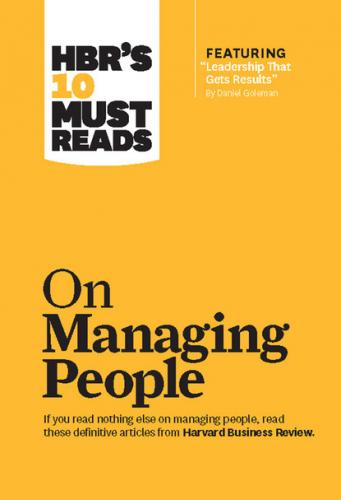HBR's 10 Must Reads on Managing People (with featured article "Leadership That Gets Results," by Daniel Goleman). Daniel Goleman
target="_blank" rel="nofollow" href="#fb3_img_img_594b8b20-35fe-57eb-9557-82dc7bc27029.png" alt="cover"/>
On
Managing People
HARVARD BUSINESS REVIEW PRESS
Boston, Massachusetts
Find more digital content or join the discussion on www.hbr.org.
The web addresses referenced and linked in this book were live and correct at the time of the book’s publication but may be subject to change.
Copyright 2011 Harvard Business School Publishing Corporation
All rights reserved
No part of this publication may be reproduced, stored in or introduced into a retrieval system, or transmitted, in any form, or by any means (electronic, mechanical, photocopying, recording, or otherwise), without the prior permission of the publisher. Requests for permission should be directed to [email protected], or mailed to Permissions, Harvard Business School Publishing, 60 Harvard Way, Boston, Massachusetts 02163.
Library of Congress Cataloging-in-Publication Data
HBR’s 10 must reads on managing people.
p. cm.
Includes index.
ISBN 978-1-4221-5801-2 (pbk. : alk. paper)
1. Supervision of employees. 2. Management. 3. Personnel management. I. Harvard business review. II. Title: HBR’s ten must reads on managing people. III. Title: Harvard Business review’s 10 must reads on managing people.
HF5549.12.H395 2010
658.3—dc22
2010031618
eISBN: 978-1-4221-7204-9
Contents
by Daniel Goleman
One More Time: How Do You Motivate Employees?
by Frederick Herzberg
by Jean-François Manzoni and Jean-Louis Barsoux
Saving Your Rookie Managers from Themselves
by Carol A. Walker
What Great Managers Do
by Marcus Buckingham
Fair Process: Managing in the Knowledge Economy
by W. Chan Kim and Reneé Mauborgne
Teaching Smart People How to Learn
by Chris Argyris
How (Un)ethical Are You?
by Mahzarin R. Banaji, Max H. Bazerman, and Dolly Chugh
The Discipline of Teams
by Jon R. Katzenbach and Douglas K. Smith
Managing Your Boss
by John J. Gabarro and John P. Kotter
About the Contributors
Index
Leadership That Gets Results
by Daniel Goleman
ASK ANY GROUP OF businesspeople the question “What do effective leaders do?” and you’ll hear a sweep of answers. Leaders set strategy; they motivate; they create a mission; they build a culture. Then ask “What should leaders do?” If the group is seasoned, you’ll likely hear one response: the leader’s singular job is to get results.
But how? The mystery of what leaders can and ought to do in order to spark the best performance from their people is age-old. In recent years, that mystery has spawned an entire cottage industry: literally thousands of “leadership experts” have made careers of testing and coaching executives, all in pursuit of creating businesspeople who can turn bold objectives—be they strategic, financial, organizational, or all three—into reality.
Still, effective leadership eludes many people and organizations. One reason is that until recently, virtually no quantitative research has demonstrated which precise leadership behaviors yield positive results. Leadership experts proffer advice based on inference, experience, and instinct. Sometimes that advice is which precise leadership behaviors yield positive results. Leadership experts proffer advice based on inference, experience, and instinct. Sometimes that advice is right on target; sometimes it’s not.
But new research by the consulting firm Hay/McBer, which draws on a random sample of 3,871 executives selected from a database of more than 20,000 executives worldwide, takes much of the mystery out of effective leadership. The research found six distinct leadership styles, each springing from different components of emotional intelligence. The styles, taken individually, appear to have a direct and unique impact on the working atmosphere of a company, division, or team, and in turn, on its financial performance. And perhaps most important, the research indicates that leaders with the best results do not rely on only one leadership style; they use most of them in a given week—seamlessly and in different measure—depending on the business situation. Imagine the styles, then, as the array of clubs in a golf pro’s bag. Over the course of a game, the pro picks and chooses clubs based on the demands of the shot. Sometimes he has to ponder his selection, but usually it is automatic. The pro senses the challenge ahead, swiftly pulls out the right tool, and elegantly puts it to work. That’s how high-impact leaders operate, too.
What are the six styles of leadership? None will shock workplace veterans. Indeed, each style, by name and brief description alone, will likely resonate with anyone who leads, is led, or as is the case with most of us, does both. Coercive leaders demand immediate compliance. Authoritative leaders mobilize people toward a vision. Affiliative leaders create emotional bonds and harmony. Democratic leaders build consensus through participation. Pacesetting leaders expect excellence and self-direction. And coaching leaders develop people for the future.
Close your eyes and you can surely imagine a colleague who uses any one of these styles. You most likely use at least one yourself. What is new in this research, then, is its implications for action. First, it offers a fine-grained understanding of how different leadership styles affect performance and results. Second, it offers clear guidance on when a manager should switch between them. It also strongly suggests that switching flexibly is well advised. New, too, is the research’s finding that each leadership style springs from different components of emotional intelligence.
Idea in Brief
Many managers mistakenly assume that leadership style is a function of personality rather than strategic choice. Instead of choosing the one style that suits their temperament, they should ask which style best addresses the demands of a particular situation.
Research has shown that the most successful leaders have strengths in the following emotional intelligence competencies: self-awareness, self-regulation, motivation, empathy, and social skill. There are six basic styles of leadership; each makes use of the key components of emotional intelligence in different combinations. The best leaders don’t know just one style of leadership—they’re skilled at several, and have the flexibility to switch between
